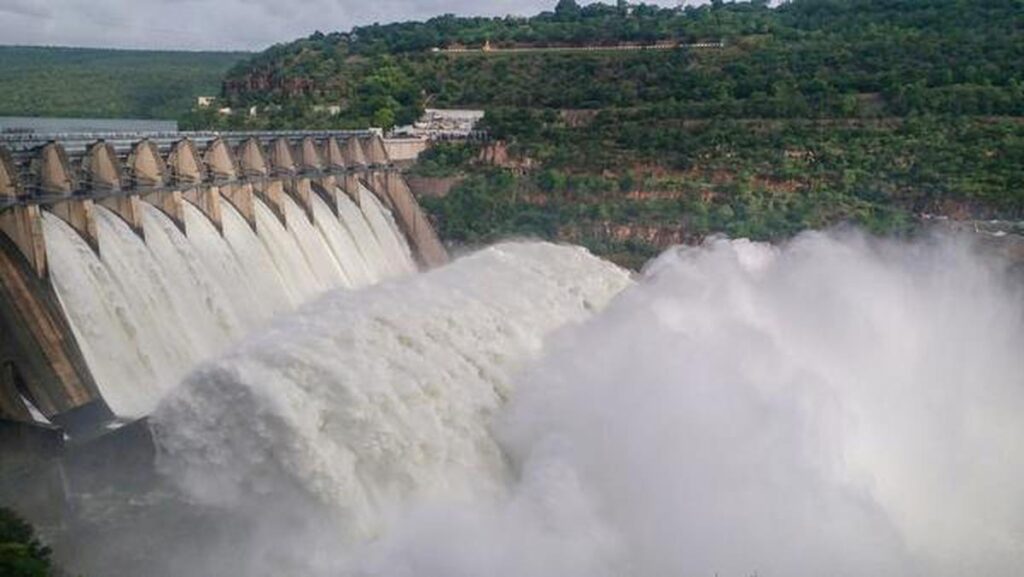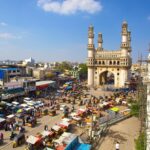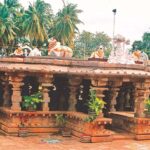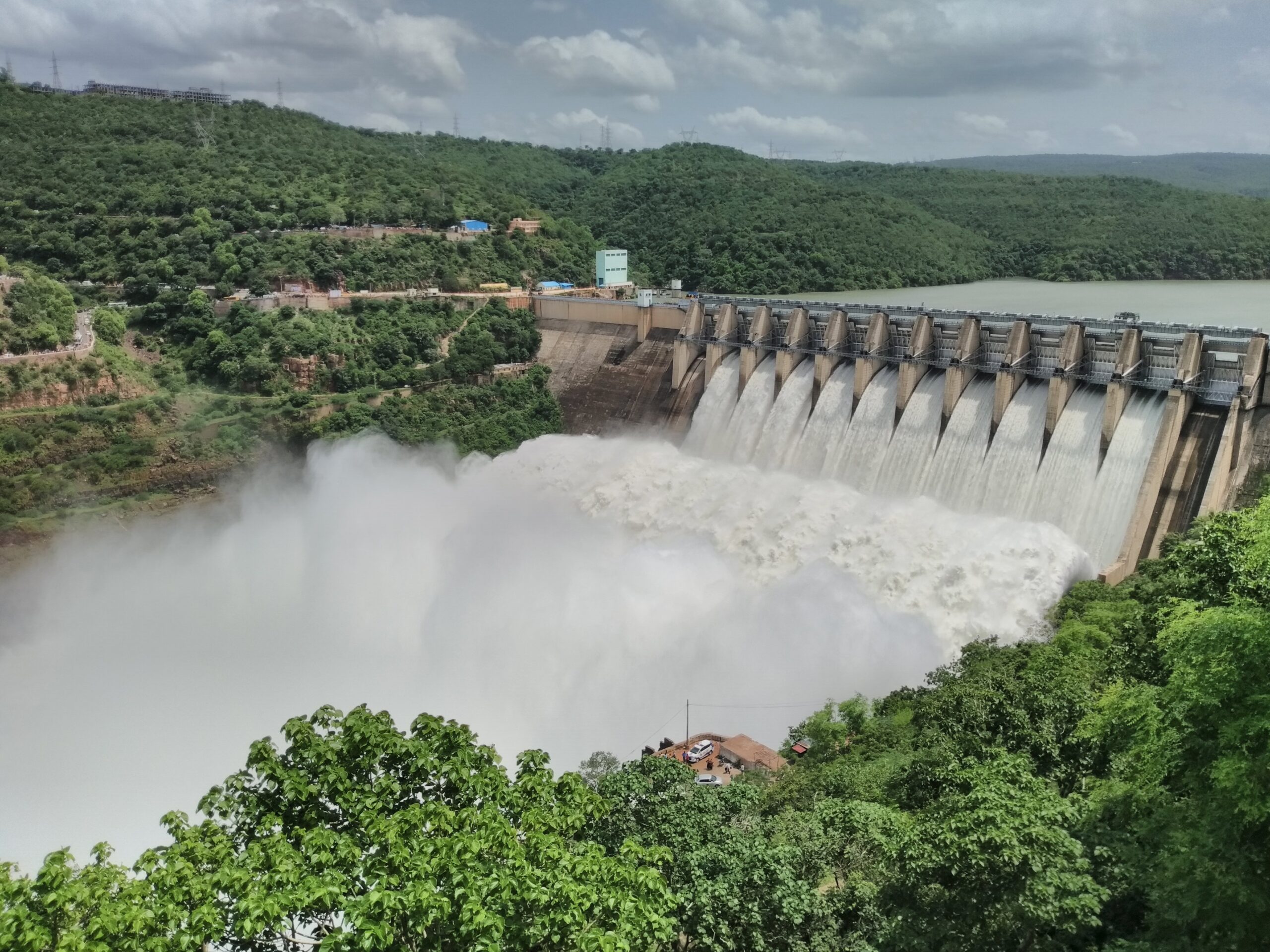The Srisailam Dam, built across the Krishna River in Telangana’s Nagarkurnool district and Andhra Pradesh’s Nandyal district near Srisailam temple town, is India’s second largest working hydroelectric station.
The dam was built in a deep gorge in the Nallamala Hills between the districts of Kurnool and Nagarkurnool, 300 metres (980 feet) above sea level. It is 512 metres (1,680 feet) long, 145 metres (476 feet) tall, and has 12 radial crest gates. It has a 616-square-kilomete reservoir (238 sq mi). At its full reservoir level of 885 feet (270 m) MSL, the project’s estimated live capacity is 178.74 Tmcft. It has a total storage capacity of 6.116 cubic kilometres (216 tmc ft).
The reservoir’s minimum draw down level (MDDL) is 705 feet (215 m) MSL from its river sluice gates, and the corresponding dead storage is 3.42 Tmcft.The underground power station on theleft bank has a capacity of 6 150 megawatts (200,000 hp) The right bank semi-underground power station houses 7 × 110 megawatt (150,000 hp) Francis-turbine generators and reversible Francis-pump turbines for pumped-storage operation (each turbine can pump 200 cumecs).

A tail pond dam/weir is being built 14 kilometres downstream of the Srisailam dam to hold the water released by the hydro turbines and later pump back into the Srisailam reservoir by operating the turbines in pump mode.
The weir portion failed to withstand the normal water release from the hydro power stations in November 2015.
The tail pond weir was finished in 2017, and pumping mode operation continues even when the downstream Nagarjuna Sagar reservoir water level falls below 531.5 feet (162 m) MSL.
The tail pond has a capacity of nearly 1 tmcft for live storage.
Srisailam Dam history
The Srisailam project began in 1960 as a power project only. The main dam was finally completed twenty years later, on July 26, 1980, after several delays. [Citation required] Meanwhile, the project’s second stage, completed in 1987, transformed it into a multipurpose facility with a generating capacity of 770 megawatts (1,030,000 hp). [Citation required] The dam is expected to supply water to an area of approximately 2,000 square kilometres (770 sq mi). 790 square kilometres (310 square miles) in Kurnool and Kadapa districts will have guaranteed irrigation thanks to the right bank branch canal.
The total cost of the multipurpose project was estimated to exceed $10 billion in its expanded form, up from an initial modest estimate of 384.7 million for a power project.The dam alone cost$4.04 billion, not including the installation of four 110 MW generating sets. The right bank branch canal is estimated to cost $4.49 billion, with the World Bank providing an initial investment of $1.4 billion. The project’s projected cost-benefit ratio has been calculated to be 1:1.91 at 10% interest on capital outlay. [Citation required].
Flooding overtopped a coffer dam in 1998. The power plant needed repairs and was out of commission for a year. On October 2, 2009, the Srisailam reservoir experienced a record inflow, threatening the dam.
Irrigation
The Srisailam right main canal (SRMC) was built with a capacity of 44,000 cusecs at the Srisailam reservoir level of 269.22 metres (883 ft) MSL to feed Veligodu reservoir (16.95 tmcft), Brahmamsagar reservoir (17.74 tmcft), Alaganoor reservoir (2.97 tmcft), Gorakallu reservoir (12.44 tmcft), Owk
This canal also provides water to the Telugu Ganga project, which provides Krishna river water to Chennai for drinking purposes.
This main canal irrigates a large area in Kurnool, Kadapa, Chittoor, and Nellore districts by feeding water to the K. C. Canal, Srisailam right bank canal, Telugu Ganga canal, and Galeru Nagari canal.The Handri-Neeva lift canal, which draws water from the Srisailam reservoir, provides drinking water to all Rayalaseema districts. The Veligonda reservoir receives water by gravity through tunnels to irrigate lands in the districts of Nellore, Kadapa, and Prakasam. The Kalwakurthy lift irrigation scheme, which draws water from the Srisailam reservoir, provides irrigation water to the districts of Mahbubnagar and Nalgonda.
Srisailam left bank canal will receive water by gravity through tunnels and be used to irrigate lands in the Nalgonda district. The tunnel work is not finished, but the majority of the project area has been supplied with water by lifting water from the downstream Nagarjuna Sagar reservoir.
Srisailam Dam Maintenance and Safety
Systematic neglect and a lack of diversion of funds are evident in dam maintenance and the lack of any attempts at powerhouse modernization. The officers report a lack of maintenance personnel. Safety concerns about the country’s second largest hydroelectric project have been raised over the years and have been proven false. The dam, which was designed for a maximum flood of 19 lakh cusecs, experienced a flood of 25.5 lakh cusecs in 2009. According to a survey conducted in the summer of 2018, the scouring caused the formation of a massive pit in the dam’s apron downstream. A structure protecting the main dam’s ‘toe’ and foundation has also weakened. The dam is still being repaired and maintained.
Power generation optimization
At the moment, the initial inflows into the Srisailam reservoir are excessively stored and not used for power generation. The flood water quickly fills the remaining empty Srisailam reservoir, and the majority of it overflows into the downstream Nagarjunasagar reservoir, where it is not used for power generation.The goal will be to completely fill the Nagarjuna Sagar reservoir with the uniform water released by the power generating units.
When the downstream Nagarjuna Sagar reservoir level exceeds 560 feet (171 m) MSL, the existing right bank power station (770 MW) can be converted into pumped storage hydroelectric power (PSHP) and operated in pumping mode. During drought years, the PSHP can be used for daily energy storage as well as to transfer Godavari water to the Srisailam reservoir.
Alternatively, the existing power station’s tunnel could be used to build a new PSHP station to pump water from the Nagarjuna Sagar reservoir to the Srisailam reservoir.







